|
|
1. Introduction
|
|
|
|
As often it happens with great characters equally, it seems, has to happen for this dog. Everyone would like that their region had been to have originated and have given him the name accordingly.
Too bad that all logic is sometimes overwhelmed by a fierce pride and everything will complicate, confuse ideas, and Hamlet doubts create doubts, uncertainties and useless diatribes. For my beginning, in any case, than the opinions of others even at odds with mine, I try to expose them, try them and document them and then letting others to compare them and then get to the truth. So I would like to happen on this occasion.
The National Agency of the Italian Kennel Club in 1958 officially attributed to this dog, named "Maremma Abruzzese Shepherd Dog" when, seemingly resolved all disputes, found that all were in agreement that the Maremma, understood as "maritimae "ie land which faces the sea, and Abruzzo were the two rooms where the dog had had its splendid development, were the two territories in which the dog population in question was, at that moment, most represented, present and active in many pastoral initiatives in the above said areas formed the main base of the economy, and, in these two environments our dog was always present in this last millennium.
But you are not given due consideration to the Abruzzo and the Maremma represented the cornerstones of a secular system, that of transhumance, which bound them, and that the dog was not only present in the Abruzzi and the Maremma area, but in the entire back Apennine, on which, do not go forgotten, it was practiced pastoral activity. The Apennines, everything, had given birth and life to the shepherds and their flocks, mainly sheep, which, during the long winter months, the snow fell abundantly to cover the pastures, forced them to get off the plane, for absolute survival needs. But what I will return. In that year was celebrated, then, the dog's baptism from Maremma-Abruzzese Shepherd. He was given the name that currently leads because the ENCI, with the collaboration of Professor valiant Solaro, the Technical Committee of the Circle of the Maremma-Abruzzese Shepherd and of some experts, it resolved after indicating the ethnic character of the race and completed the standard which, among other things, in the brief history, says "... and, sheepdogs once present in the Tuscan and the Lazio region. ... ". From that moment he opened a new chapter in the long history of this important Italian breed.
It was right and proper to unify the two existing breeds, "the Maremma" and "Abruzzo", because races were not, but if you ever variety, since there were no differences between them, neither morphological nor aptitude that had character of genotipicità.
The ENCI decided he also wanted to quell tempers, quell the heated passions that animated those who claimed, with drawn sword, and without reason, and claimed: the dog is Maremma; no, the dog is in Abruzzo, and discussed endlessly, without being in agreement, just because they were animated by exasperated parochial spirit, without clear ideas, devoid of technical and historical knowledge, and even common sense. It seemed the result of a compromise and those who, like myself, was following the story and the story of the race, I felt, I remember; Regrets ...
|
|
|
|
|
|
|
|
2. The Asian continent and origins
|
|
|
|
The doctrine is almost unanimous in believing that the true origin of this breed dates back to many centuries ago, and that his real birthplace was the distant Tibet at the Arii. History tells us that this people devoted to agriculture and pastoralism, 2000 years before Christ, began a slow shift toward the West, driven by needs space and fertile land, necessary for its survival. It's enough to take a look at the map depicting the Asian and European continent to realize that the same could not be present no alternative.
Topped with great sacrifices and hardships the Karakorum, the Pamir and Turkestan Occ., Avoiding to leave the 40th parallel not to run into very cold weather, these people offered a wide expanse of flat, fertile and rich waters: the lowlands Turanic with the great Aral Sea, which could assure him plenty of pastures, soil fertility, good hunting and good fishing. In this area, of course, the break was long, probably for centuries.
In the wake of these people moved even herds of cattle, guided by a number of dogs are also committed to their protection. These dogs certainly can be considered the ancestors of many current European breeds, including our.
This population, meanwhile grown in number, was forced to return to the path again towards the West, towards the Sea of Azov, the southern Ukraine, Podolia and the great valley of the Danube. Here there was a long pause, then again divisasi into two groups, headed north towards the Hungarian plain and to the heights of the Hellenic peninsula. It turns out that the largest group was that headed north. So Europe resulted invaded by these people, part of which still crossed the Alps, swept in the Po Valley and from here in the long Apennine ridge and the two riparian strips which it originated, to the south of the peninsula..
The Aryans are remembered as a quiet and peaceful population, engaged in the work of the fields, breeding and commerce. Not for this, however, their slow move was quiet and bucolic their behavior. Sometimes he became aggressive, violent, cruel, barbaric, especially in the encounter with other indigenous peoples unwilling to accept them.
Their journey to the West was opposed by the Roman Militia who intended to extend the Empire's borders to the East, since the North that had already happened. Begins the Roman occupation of the Pannonia, Dalmatia, Dacia, Thrace, Macedonia, Asia, Cappadocia, Armenia and their colonization.
|
|
|
|
|
|
|
|
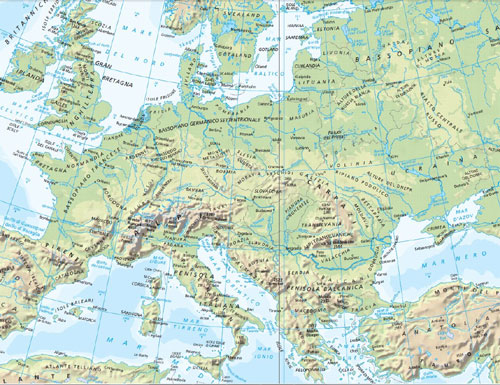
|
|
|
|
|
|
|
|
3. The Italian peninsula and history
|
|
|
|
The customs of the people do not change, however, and the agriculture and grazing remain the primary activities even if in the meantime other centuries have passed and men and animals, including dogs, went to meet the lens, but already visible changes in their appearance and in their behavior.
But back in Italy.
The Po Valley was at that time a large expanse of green, rich in streams and with a pleasant climate. The Apennines appeared for the people of origins montanare a habitable area, because it is made from non inaccessible hills and broad valleys where parking and were insured shelter. The vegetation is represented by vast clearings pascolative and oak forests, chestnut and beech, guaranteed the supply of various species of their properties: mainly sheep but also cattle, horses and pigs.
Lower "closed" also allowed cereal crops, and arboreal as the vine and the olive. And in certain areas was born on the farm, of which reads: "have the farm hedges and thick and tall, the banks, or the ditches or fences or walls so that the animal does not come."
Further south, the Apennines always appeared changed as the forests were replaced large limestone massifs such as the Monti Sibillini, Reatini, Sabini, Simbruini, Ernici with the Gran Sasso, the Velino, the Maiella, the Meta, the Matese. However, able to ensure the life to men and animals, even if with a different and more problematic rude. br>Both the Apennines, the eastern and western formed in turn habitats in which, with the turning of the seasons, it was easy transit with short breaks for animal feed and the exercise of commerce and trade. The two rivers, "the marshes", so named from the Latin word "maritime", which "overlooks the sea" that is, to which flowed into these natural paths "sheep tracks", formed the ring with which you created the soldering needed for all the life cycle of the animals and the men who had the last one year including the summer and winter and vice versa.
|
|
|
|
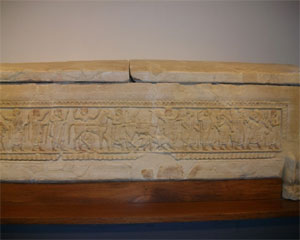
|
|
Archaeological Museum of Perugia: Roman scenes
|
|
Apennines in these areas created a close relationship that became known as "transhumance" (slow transfer).
Practice existed at the time of the Romans, as well as some classics mention it, and that history shows, talking about "Calles pubblicae" (public footpaths), with grazing privilege and transit, which Teodisio (a. 400) and Justinian (a. 480) encode. Woman in this territory nostrano the breed in question spends the most significant moments of its phylogenetic development, it is becoming more and more similar appearance to the current ones. But the Etruscans had acquired certain similarities.
|
|
|
|
|
This people is a lover of dogs and often depicts them. We have much archaeological material which confirms the above. For example: the Archaeological Museum of Perugia, on a side of a sarcophagus known as the "Memorial stone of Perugia", bas-relief, we see the figure of a large dog, long-haired and slightly wavy, light-colored , with lupus type head, small ears, slightly horizontal and facing forward, that after all, regarded the subsequent changes, may also appear as an ancestor of our shepherd Abruzzese Maremma.
|
|
|
|
The Romans called it "dog in sheep" even as the shepherds of the Apennines and the plains, both North and South.
Cato (234 BC) calls it "canis pastoralis", then "pecuarius" when frequently named him in his work "De Agri Cultura", in which precise, very important fact, which justify my subsequent statements that is different from "canis epiroticus" (bulldog Epirus, then Molossia) that is dark mantle, heavy head and body, short-haired, fierce, suitable for guarding the "house"; which is also different from the dog "laconicus" or "Spartan", which fawn coat, light head and body, short-haired, fast, suitable for hunting.
|
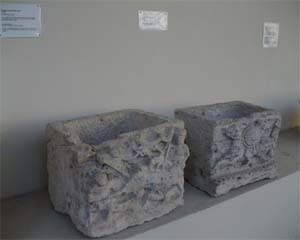
|
|
Archaeological Museum of Perugia: rural scenes
|
|
|
|
|
|
This classic dog knew well, because we read of his life: the son of wealthy farmers, worked alongside his slaves, tending personally to the large cattle he owned: cattle and sheep, originally from Podolia, the region that is that the Aryans had crossed , remaining long and from which many breeds today, existing in Italy: the Romagna, the Marches, the Maremma, Pugliese, are derived. I do not think it can be considered a fluke that these races were in the regions where it is the large presence of our Abruzzese Maremma dogs.
So do not think it's a coincidence that similar breeds: Hungarian herdsman (Kuvasc); Tatra mountain dog, mountain dog of the Pyrenees and Andorra, are in the regions in which the people previously appointed has passed, has stood for many years with his animals, including dogs. Contact How does it turns out, despite having done much research, that dogs of this type are frequent nell'Ellade.
Therefore, I think it can be easily demonstrated that, from this Italian sheepdog with us, descended slowly from north to south, and not the other way around .
|
|
|
|
|
|
|
|
4.The historical disputes
|
|
|
|
And 'here, on this last hypothesis, the object of the dispute that arises with those who say that "the best hypothesis to explain the spread of the dog in Italy is to think of a dog after spreading from Asia to Greece, and from there its subsequent export in southern Italy ". Nor a long description of the Abruzzo sheep is sufficient to validate the claim for which the dog should be called "Abruzzo", as herding is a primary activity, even if with ups and downs, of other Italian regions.
|
|
|
|
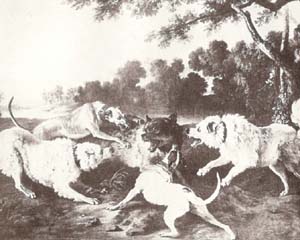
|
|
"Wolf attacked by dogs" by Jean-Baptiste Oudry (1686-1755), Muzzle Compiègne
|
|
I think Marco Terenzio Varrone "the Reatino" (116/27 BC), which often also implicates other, I can be of great support. In his "De Rerum Rusticarum" is a broad description of "canis pastoralis" indeed his, that many kept with their flocks that "nam mihi Greges in Abulia hibernabant here in Reatinis montibus estivabant ... .. sic calles publicae distantes pastiones ", adding that" capitibus auriculis et magnis et flaccis "," Potissimum color register ".
In recommending the choice continues "item videndum seminii sint ut boni; itaque et a regionibus appellantur Lacones, Epirotici, Sallentini.
This sentence must be understood, in my opinion, unlike
|
|
|
|
|
those who said that the dogs in question come from these Greek regions (certainly not Sallentini), then the best ancestors with him, and that is: as a recommendation because you take care that the dogs are of good seed, as are Epirotici dogs, Lakonia and the Salento.
Jerome's translation Pagani Even that reads a text published in Venice in 1846 by Giuseppe Antonelli confirms publisher, as well as that of Alfredo Bartoli in the main text "Roman Collection" of E. Romagnoli of the Royal Academy of Italy, Ed. Notari Milano 1930.
Repeat these concepts also Virgilio (70/19 BC) in the Georgics when he writes: "nec tibi care canum postrema fuerit, sed a veloces Spartae catulos acremque Molossum grazes serum fat ones "which translated means: do not put behind him the care of dogs, but feed them abundantly as fast dogs of Sparta (lacones) and the ferocious mastiff (epiroticus).
Li also repeated Horace writing" nam aut qualis Molossus, aut fulvus Lacones, vis pastoribus friend ". He repeats that the dogs of Laconia are tawny, and, today, it is absolutely unacceptable to say, to establish a relationship, that even in the Abruzzo from Maremma sheepdog sometimes appears fawn, considered genetically phase prior to white.
|
|
|
|
|
|
|
|
5. Pastoralism and his sheepdog: widespread primary activity throughout the Italian peninsula.
|
|
|
|
5.1 Historical background, social and economic.
|
|
|
|
With regard to the pastoral activities in Italy it is easy to document its spread throughout the country and particularly in the center and south.
And 'necessary to go back a little back in time and see all the Italian events, historically related
|
|
|
|
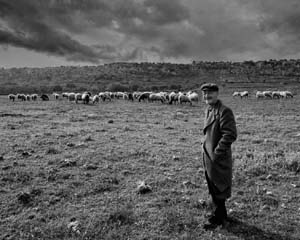
|
|
Pastoralism apennine
|
|
At least back to the Middle Ages, where the frequent succession of foreign and domestic rulers provoked the occurrence of ups and downs in all fields. With Odoacer (476) and then by the Goths (490/553) the large property was reduced and the agriculture and livestock we took advantage. With the Byzantine domination (553/569) and the Lombards (569/774) returned the peninsula to a moral misery and profound material. The fields became deserted and derelict villages for the continuous wars, the cattle dispersed. The Italian population did not exceed six million inhabitants, mainly devoted to the activity, forestry / pastoral.
|
|
|
|
|
The Papacy called the Franks, subdued the Lombards and settled in the land (774/888). She gave birth to feudalism which lasted until about 1300 in the North, while in the South began the Norman period that lasted more or less until the French Revolution. The Frankish kings assigned to their dignitaries large properties, sometimes entire regions. Were born Vassalli (laity and bishops) and vavasours with privileges to employees' ius lignandi and pascendi "with cereal and pastoral economy.
Then began the struggle between the Papacy and the Empire (Germanic succeeded that Carolingian), which ended with the Municipal freedom. The islands were passed under Arab rule.
Some religious orders, the Benedictine and Cistercian took place in the meantime meritorious work in the field of culture and in the agrarian. After the municipalities began the Lordships: the Visconti, the Sforza, the Este, the Scaligeri, the Gonzaga, the Medici and others that split wide areas of the north and center. Meanwhile, as previously mentioned in the South the Normans (1060/1190), the Swabians (1190/1266), the Anjou (1266/1435) established their domination resulting in periods of wealth and poverty. In southern sheep farming it was developed especially; Federico ΙΙ (1198/1250) reorganized the tracks and tooling up, in Puglia formed the "Mena sheep". From Spain they were introduced many subjects of valuable race, to improve the production of wool. In the center, the Popes did not consider to be less this type of farming that took considerable size, so that concerned about it, to protect the cattle intervened by limiting the pastures. The Governor of Piediluco (1484) settled in the areas where these could be maintained, "so that they can comfortably sustain beef cattle and other large animals, which for the large number of sheep and goats can not support themselves, indeed, for the shortcomings herbs, plus diminish and deteriorate. "
Then he settled in Italy the Spanish domino (1536/1706 in the North) and (1409/1713 in the South), which provoked sensitive economic, stopping the agricultural progress that had started . Particularly in the South, some baronial caste had set making the population quiescent, for customers or fatalism. Ristorante Al Nord awakening was quickest to a different mentality of the people and for the good fortune to pass under domination more tolerant and active, such as occurred in Tuscany, he uses of Lorraine (1737/1790) who started and they finished works of great importance both in the field of agronomy and in the reclamation. The Maremma underwent a profound and wide remediation saw used almost all its vast territory for the breeding of cattle and sheep.
The French Revolution also provoked in Italy deep repercussions in social and economic sectors. It began to form the agrarian private ownership of different sizes, even considerable, operating with a more modern mentality compared to at least that of the past, both as regards the relationship between master and employee, both as regards the already entrepreneurial mindset that you went spreading.
The French Revolution also provoked in Italy deep repercussions in social and economic sectors. It began to form the agrarian private ownership of different sizes, even considerable, operating with a more modern mentality compared to at least that of the past, both as regards the relationship between master and employee, both as regards the already entrepreneurial mindset that you went spreading.
|
|
|
|
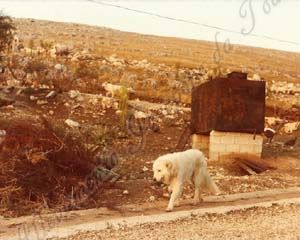
|
|
Travel apennines
|
|
You start to notice the gap between the North, the Center and the South for a progress as it moves towards the future with descending movement as the latitude.
Meanwhile, the Italian population had grown from 18 million in 1800 to 25 million 1860, and food production had achieved self-sufficiency.
the Unification of Italy causes a natural disorientation, of which still a few traces is detected.
the exploitation of the land and livestock He begins to diversify: intensive in the North, not the center, extensive even in the South.
|
|
|
|
|
The sheep population, which is the one that most interests us because in it we find proportionally the presence of our dogs reached by the years 1866-1908 substantial numerical and qualitative levels, doubling the actual reaching the vast amount of about 12 million head. This consistency will be the maximum peak reached, from which to facts known to all and therefore do not report, began a slow and steady descent.
|
|
|
|
|
|
|
|
5.2 Why this name
|
|
|
|
This historic glimpse aims to inform the reader of the national sheep situation had arisen through the centuries, but also wants to demonstrate and prove how they are not only the Abruzzi were to have a pastoral tradition, but can certainly were also Lazio, Umbria, Marche, Tuscany. All regions have testified that the presence of sheep followed the 'tireless custody of sheep dogs that we talked about and we noticed more or fewer depending on the fortune or misfortune of pastoralism in that or that other area.
This historic glimpse aims to inform the reader of the national sheep situation had arisen through the centuries, but also wants to demonstrate and prove how they not only were the Abruzzi to have a pastoral tradition, but can certainly have been even other Apennine regions: Lazio, Umbria, Marche, Tuscany, Puglia. All regions have testified that the presence of sheep followed the 'tireless custody of sheep dogs that we talked about and we noticed more or fewer depending on the fortune or misfortune of pastoralism in that or that other area.
|
|
|
|
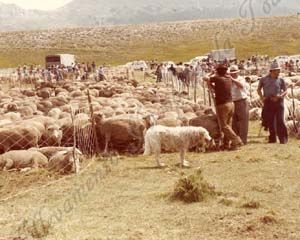
|
|
Travel apennines
|
|
The last big war has deeply shocked this activity, because the fiercest conflict is expressed along the Apennine ridge and its natural buttresses and along the coasts, where the constant fear of landings had alienated the people and the flocks. A
this material transformation followed the moral and much has changed. In certain regions herding sold permanently, in other areas it has reduced the size and enthusiasm, such as in Abruzzo; in other areas, such as in the Tuscan hill, Marche, Umbria, Lazio has transformed farming systems that transhumance has become sedentary.
|
|
|
|
|
People pastoralists for generations have left, as have abandoned the sharecroppers who led the breeding farm road typical of a sharecropping territories. These vast piedmont territories were purchased by Sardinian shepherds. People have changed and the breed of sheep, certainly mostly Sardinians, but not dogs, recognizable by their nature, to carry out their secular function.
That's why I wanted to address many aspects of the problem, the historical aspect it is important, what socioeconomic equally, what dog fanciers not less, all are precise and consistent in the rightness of the denomination that has our "Abruzzese Maremma Sheepdogs" dog, because just the name of "Abruzzese" would not be as good motivation, but only deprivation value of its universal meaning. This name should accompany him in his future evolution because, ironically, if you were to take account of its greater or lesser presence in a territory, and in consideration of this should be attributed to him the name, this would ultimately be continually modified over the centuries and therefore doomed to be temporary or constantly dependent on opinions and views of either.
|
|
|
|
|
|
|
|
5.3 One theory baseless
|
|
|
|
We are in the year 1988, on April 30 at the Eagle, and yet, what was envisaged in this last part, it happened.
|
|
|
|
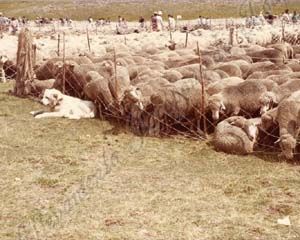
|
|
Travel apennines
|
|
In a conference organized by the Region of Abruzzo, some local politicians, explaining their law for the protection of the Abruzzi shepherds dog, they have proposed a new and unique name: "Abruzzese Mastiff". Among the various reports, Breber, CNR, said: "The homeland of the breed is the Abruzzo."
The chief editor of an influential monthly cinofilia in the debate, he asserts: 'recognition of a race can take place in three years', not specifying, however, if he intended from the standpoint of phylogenetic, or bureaucratic, administrative.
Veritable slogans! Who pronounced on that occasion and on that occasion, they could have been accepted, though out of the mouth of less qualified people.
|
|
|
|
|
And then, as in Italy, unfortunately, in the Kennel Club, talking about dogs, often, too often, are people with vague knowledge of livestock, which they consider the pet dog unlike any other, so-called farm animal, you can not be silent and not step in and say, quite frankly, albeit with some regret, that you should not theorize the dog world in general and the Abruzzese Maremma shepherd dog in particular, having superficial knowledge of Science, Biology, Anatomy and animal Physiology, animal husbandry, let alone quibble topics of phylogeny and taxonomy, without, however, take into account the social historical context, in which a race has been formed, then developed and evolved.
|
|
|
|
|
|
|
|
5.4 livestock analysis, phylogenetic and taxonomic - "Race to the Apennine shepherd"
|
|
|
|
All General Livestock texts report the various evolutionary theories of Vanini, E. Darwin, Lamarck, of Saint Hilaire, C. Darwin, De Vries and many other contemporaries.
Equally The criteria with which you must proceed to the qualification of species and breeds, according to Linnaeus, Cuvier, Buffon, Cornevin, Dechambre.
damage the significance of species, breeds, varieties, home or cot.
topics to adduce here are treated by these authors.
a) to breed means a set of individuals with their own characteristics at the anatomical, physiological, morphological, transmitted to the offspring.
b) For its formation, as Mendelian population, made up of genotypes or better even genes, originated by segregation of them in gametogenesis, more influenced by various environmental factors, through a varied succession of phenomena, takes a long time, certainly decades.
c) That the environment, sometimes restricted, in which it is formed and realized, called the cradle or home.
d) that its name is derived, usually, from the name of this territorial environment, geographical, sometimes with the addition of some attribute, which most do It allows the identification and differentiation.
|
|
|
|
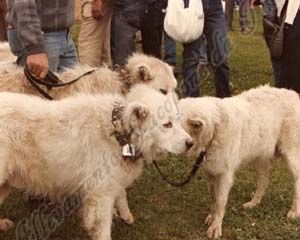
|
|
Travel apennines
|
|
Because with this criterion, have had the name all breeds in animal science, it is not clear why the same should not be done for this breed of dog.
Remember: in cattle there is the Chianina, Marchigiana, Romagnola, fate in Val respectively di Chiana, the Marche and Romagna; equine exists race Sarda, Sicilian, Murgese, whose cradle is respectively Sardinia, Sicily, Murge; exists in sheep race Vissana and Sopravissana, the Bergamo area, the Leccese, the Apennines, from Visso, Bergamo, Lecce, Apennines.
ENCI in 1958, he adopted this policy, when you gave it the name "shepherd breed Abruzzese Maremma ": evidently considered the Maremma and Abruzzo the territories in which the breed had appeared, formed, evolved.
|
|
|
|
|
Certainly if, at that time, we had been more diligent and responsible in following our race, which conversely had overlooked, and that we, the survivors, we have grave offense, we would have had good reason to give it a name certainly more proper, the which all, today, we would have been more satisfied and that is: "Apennine breed shepherd", given that the entire Apennine ridge it had appeared even before the Maremma area, even before Abruzzo, because here he found his second "cradle", after his arrival in Italy, through the Alps. How do we forget that in the Tatra Mountains, we have the dog Tatra, in Hungary, we have the Hungarian Shepherd in the Pyrenees have the Pyrenean Mountain dog, all stemming from the same stock.
If ENCI, in 1958, had followed a livestock policy and had taken account of scientific principles, such as those of the phylogeny and taxonomy of the races, as well as had been done for all the other zoo-agricultural type breeds, would give it to our race a more appropriate name, and more proper, namely, which rationally belonged: on the Apennines Shepherd dog, because this, again, is the part of Italy where the white dog appears here and spends much part of the year, from May to November, with the shepherds, here have their home, their place of residence, here leave their family, even when transhuman. With A similar solution it would have been a compromise, but it would appear, as well as courageous and radical, certainly the most rational because it would leave everyone happy and peaceful. He would find its justification in the whole history of Italian highly developed sheep farming and pastoralism.
|
|
|
|
|
|
|
|
5.5 The Abruzzese Apennines
|
|
|
|
Let's go back to Abruzzo, that the friend Paul Breber said to be the dog home. I recognize that this region, which has his own particular configuration, which is concerned mainly with high Apennines and rocky outcrops, not everyone Pasture, with an undeniable pastoral tradition, has played its part in the formation of our breed, but not exclusively, because historically speaking, the same race was present in the Apennines Umbria and Marche, in the Tuscan Romagna and Lazio.
As I wrote, in the distant past migrations of nomadic people, devoted to agriculture and pastoralism coming from the center of the Asian continent, also reached Italy and settled first in the territories where the pastures were abundant and waterways permanent and mild climate, and here they remained for a long time. So, in the needs of other areas, probably pressed by the migration of other peoples, they went and they stopped in the mountainous stretches more affordable and better suited to their lives and that of their animals; later they occupied other traits, less accessible, more bitter and less hospitable, steeper, but still essential for the sustenance of their flocks and herds, which in the meantime had grown in number.
tract Abruzzese Apennines was probably affected by this migration much later, because less hospitable for its natural geophysics and the character of its people.
However, compared to other traits, the Abruzzi Apennines had the advantage of being relatively close to the plains, such as Maremma, Lazio and Puglia, even if this advantage really became usable only after the opening of passages and crossings and the extension of cattle-tracks already exist at the price of immense human labors. Login This happened only in the fifteenth century, when the Abruzzo broke its millenary isolation and established contacts with Rome and its countryside, with Reatino, Umbria and the Marche and Puglia in the south, where flocks in summer could flock en masse, by virtue of the edict of Alfonso I of Aragon, it became active in the year of grace 1447.
I repeat, the Abruzzo until then had been almost totally disconnected from the rest of the country and forced, for its orographic configuration, in an absolute and forced isolation. He resented the late Renaissance humanist motorcycle, staying away immediately by the impact of the most significant historical events of the country, meanwhile, had involved and interested in other neighboring peoples.
Even Rome, which had widened immeasurably his empire beyond the peninsular borders, had failed to break this millennial isolation, neither was able to impose its rule over warlike peoples and irreducible, closed and protected from their insurmountable natural boundaries , in an area that, among other things, did not offer much, so much to justify a war of conquest. Abruzzo, then, also had problems of coexistence among peoples who lived there. Equi, Marsi, Peligni, Vestini, Marrucini, in eternal dispute between them, formed a community of fate rather unique, for the tenacious and stubborn loyalty to their agricultural forms, economic and social, fatally and constantly conditioned by the more primitive and more stable elements: Nature.
If these conditions favored the birth of so many ascetics and saints, isolation, lack of unified productivity of arable land, the long winters under the snow, have not allowed an appreciable development of agriculture and livestock, that has never known the formation of true farm animal breeds. The Abruzzo, therefore, can not boast, unlike other Italian regions, its own breed of cattle, horses or swine worthy of note for its production capacity and profitability, and even not a breed of sheep or goats own. Only in ancient texts mention is made of animal husbandry and is an outline of a sheep razzetta; the so-called "Dear d'Abruzzo", located to the south, on the border with Puglia, in triple attitude: milk, wool, meat, but quickly disappears from history.
the beginning of the fifteenth century, the Abruzzo sheep population was made up of a population of about three hundred thousand heads, forced to run autarkic, various indigenous breeds, and indefinite. E 'logical to think, deduce and then assert that the presence of dogs, at that time, was in connection with this limited consistency. Maybe three thousand people, where you want to consider a dog every hundred sheep. While Italy, in the same period, counted on a sheep population of over seven million head, located mainly in the islands, in the South, but also in the center, in the Marche and Tuscany, less the North. And 'always logical to infer, deduce and then assert that the presence of dogs in the rest of continental
|
|
|
|
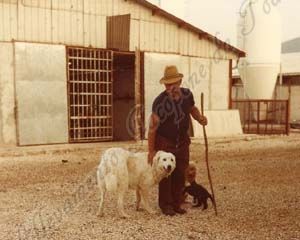
|
|
Travel apennines
|
|
Obviously they had entered in Abruzzo a very considerable number of sheep and therefore the dogs. The sheep came
introduced Umbria / Marche Apennines and were Apennine race, Vissana and Sopravissana, came from the Maremma and the Roman countryside and were the Maremma breed, came mainly from the Tableland and the captains and they were from Puglia. All races were from large production capacities, not comparable to those of their Gentile d'Abruzzo, disappeared for systematic measures of replacement and absorption cross.
The Chronicles report a massive importation of Vissana breed sheep and Sopravissana from the North and from the West, so the Maremma breed, gentle di Puglia from South race.
|
|
|
|
|
If the news does not speak specifically to proportionally entered Abruzzo also dogs from sheep, this is easily deduced, with reasoning and logic. On A considerable contribution to the regulation of crude oil displacement he was given by Customs of Puglia who has represented for centuries a strong reference point for the transhumance.
This numerical strength, in the following centuries, went constantly changing. Currently the numerical strength of the Abruzzo sheep population is about six / seven hundred thousand heads sheep and goats, ricostituitasi after a dreadful decline caused by the sad events of war the last great war. In the majority they are purebred Vissana and Sopravissana, Apennines, Puglia; in the minority, Sardinian and local. The sheep population has once again replenished with animals from the neighboring regions. Evidently were the subjects arising from the best bloodlines, in his time introduced. The same is true of dogs, of which today, the Abruzzese, not pastors, but politicians from the word easy and great imagination they say they are fathers. I would say, if anything, adoptive fathers, not natural or legitimate!
|
|
|
|
|
|
|
|
6. Final Reflections
|
|
|
|
After as reported does not find any justification the statement, according to which the homeland of our big white dog in sheep is the Abruzzo and then "only" "Abruzzo" must be called his race, slogan you hear repeated from depredation flavor , spoliation and non-compliance. I enclose also in this regard the writing of Donna Anna Corsini "How herds svernar in Maremma" published in an official bulletin of the CPMA (App. 1).
the light of all the organizations mentioned, there're no reasons let alone the conditions for the existence of another existing white race in Abruzzo, that of ' "Abruzzese" or "Abruzzese Mastiff" whose ethnic characteristics they would be quite similar to those of the Maremma-Abruzzese Shepherd, except for some little nuance of lines and profiles, not easy to detect. Unless you want to give it roots in those three thousand dogs around present at the beginning of the fifteenth century, of which we spoke at the beginning of this note, that only history remembers, but which, at least zootecnicamente speaking, They have lost the traces, as indeed have lost the traces of three hundred thousand sheep of the kind of Abruzzo race, of which three thousand dogs were in tow. It is not negligible either the condition for which, in recent years, many dogs of Abruzzo, presented by their owners, pastors, at various gatherings of Campotosto, the Eagle, and others, have had the typical award for the Maremma breed -Abruzzese and consequently the relevant certificate for their registration in the book Italian recognized LIR, representing an important genetic material for the breeders.
I hope that the above has been sufficiently comprehensive, and has brought a bit of clarity and light in the mind of anyone who is sincerely seeking the truth and legitimate.
us hope also that the bodies responsible for the protection of the breed know how to operate, can do so calmly and objectively in the pursuit of its statutory objectives, are more cautious in the selection of persons to be entrusted with positions of trust and great responsibility, are able to assert rights of the breed.
But let us hope above all that the ENCI, in this circumstance, the only body competent to conclude silly village disputes, is always able, in the future as in the past, avail themselves of highly qualified and specialized in science and livestock. And 'at stake at this moment, even the prestige and image of our dog.
|
|
|
|
|
|
|
|
Franco Simoni
|
|
|
|
|
Degree in Veterinary Medicine with honors from the University of Perugia, becomes Captain of the veterinary surgeon for the Role Health Officer College Army Vets Pinerolo (TO). Later Doctor Civil Veterinarian, Provincial Director of Livestock of the Province of Terni E.E.N.A., and Professor of Animal Husbandry Chair at the Agricultural Technical Institute "A. Ciuffelli "of Todi and assistant consultant at the University of Veterinary Medicine of Perugia, is dedicated since 1950 under the kennel Enci of sheepdogs of" Jacopone ", secretary and vice president of the CPMA, the selection of the Shepherd Dog Breed Maremma-Abruzzese and the Caucasus Mountains, of which he is the author of numerous essays and publications in numerous books and magazines dog world, collaborating with authors and Fiorenzo Fiorone Guidobono Cavalchini in the drafting of texts "Pastors Italian" De Vecchi Editore.
|
|
|
|
|
|
|
|
|
|
BIBLIOGRAPHY
|
|
|
|
“Zoognostica” Bologna 1989 Dialma Balasini – Ed. Agricole;
“La struttura della teoria dell’evoluzione” – Stephen Jay Gould;
“Naturhistorie der Vierfussigen Thiere,” – Buffon H.L.L. De;
“Le chien” – Parigi 1931 Dechambre P.;
“I Pastori Italiani” Fiorenzo Fiorone – Ed. De Vecchi;
“Le chien” – Parigi 1969 Mèry F.;
“Fisiologia veterinaria” – Milano 1944 Beccari I.;
“Geschiche des Hundes“ – Berna 1926 Tschudi W.;
“Tassonomia Classificazione e Filogenetica” Ed. Mario Canton;
“Chiens de berger, de garde, d’agrèment” – Saint-Etienne 1933 Robin V.;
“Maremma” Antonio Meocci – Ed. Olimpia;
“Le Razze Canine” Fiorenzo Fiorone - Ed. Confalonieri;
“The dog” – Stoccarda 1852 Youatt W.;
“Lezioni di zoognostica” – Milano Barbieri I.;
“Sunto delle lezioni di zoognostica canina” - Milano 1958 Solaro G.;
“Genetics and the social behaviour of the dog” – Chicago 1965 Scott J.P. e Fuller J.L.;
“Considerazioni di un amatore del cane da pastore maremmano abruzzese” VII^ Rass. Ovina Pian di Roseto
-Notizie dell’economia Teramana nn. 11-12 1982 Simoni F.;
“The natural history of the dog” – Londra1968 Fiennes R.A.;
“The dog” – Londra 1879 Stonehenge;
“ The world of the dog “ – New York 1965 Rine J.Z.;
“ Tutti i cani “ – Genova 1950 Fiorenzo Fiorone;
“Die hunde der welt “ – Zurigo 1960 Schneider-Leyer;
“ The complete dog book “ Usa 1992 American Kennel Club;
“Le lunghe vie erbose” Lecce 1981 Palasciano;
“La pastorizia transumante nell’Italia centrale e meridionale” - Marburg 1971 Sprengel;
“Il Pastore Maremmano Abruzzese” – Milano 1992 Terruzzi F.B.;
“Il cane da pastore Maremmano Abruzzese “ – Firenze 1988 Breber P.;
“Livestock-guarding dogs, an old world solution to an age old problem” –CJ VII Usa 1980 Coppinger R.;
“The dog in prehistoric and early historic” – Usa 1976 Harcourt R.A.;
“Osservazioni geografiche sulla transumanza in Italia” – Riv. Geo. Italiana 1955 Barbieri G.;
“La transumanza: storia, civiltà, cultura”- Bari 1980 Università degli studi;
“Mammalia Calabra”– Siena, Chiaravalle 1908 Riv. di Scienze Naturali;
“Protecting the flock scheep” - Usa 1981 Coppinger R. e L.;
“Transumanza ieri” – Foggia 1989 De Musso M.;
“Storia della pastorizia abruzzese” – Cerchio 1991 D’Orazio E.;
“Die prahistorischen und ihre bazinzhungen zu den g. rassen sonderdruk” – Berlino 1901 Studer T.;
“I Pastori Italiani” – Milano 1991 Cavalchini L.G.;
“Genetics of the dog” – Usa 1989 Willis M.B.;
“Svernare in Maremma” – Firenze 1991 Neri M.A.;
“Cani di Maremma” - Cani di tutte le razze Prato 1954 Malaparte C.;
“Rassegna cinofila”: 1952, n 63, 66 – 1955, n. 97;
“ Il cane nella storia e nella civiltà del mondo” – Bergamo 1930 Girardon;
“Il cane” – Milano 1897 Hoepli il Vecchio;
“Del governo delle pecore spagnole e italiane e dei vantaggi” Milano 1804 Dandolo V.;
|
|
|